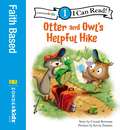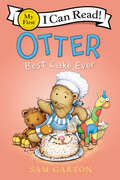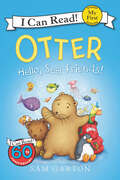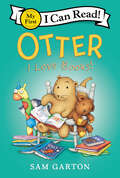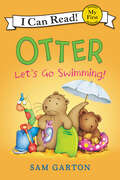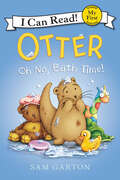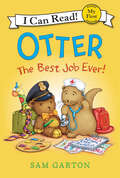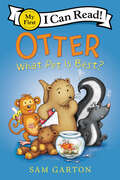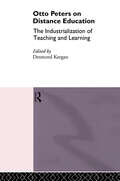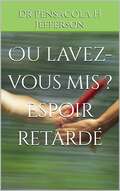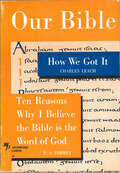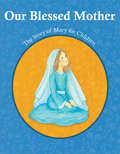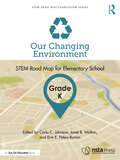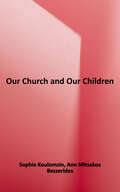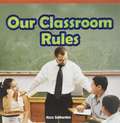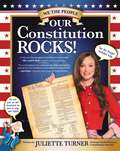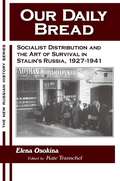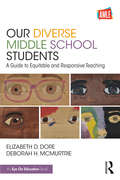- Table View
- List View
Otter and Owl's Helpful Hike: Level 1 (I Can Read! #Level 1)
by Crystal BowmanThere’s a gentle lesson about kindness in Otter and Owl’s Helpful Hike, when Otter ends up with a lot of bumps and bruises when he tries to help others. Level-two readers will enjoy this story on friendship and caring for God’s creatures.
Otter: Best Cake Ever (My First I Can Read)
by Sam GartonOn her next adventure, Otter—the irrepressible character sure to be adored by fans of Llama Llama—bakes a delicious cake for Teddy's birthday. Young readers will delight in watching Otter messily go about the cake making process!Touching on themes of patience and impulse control, Otter: Best Cake Ever is as irresistible as a cake fresh from the oven.This My First I Can Read book is carefully crafted using basic language, word repetition, sight words, and sweet illustrations—which means it's perfect for shared reading with emergent readers. The active, engaging My First I Can Read stories have appealing plots and lovable characters, encouraging children to continue their reading journey.Read about more of Otter’s adventures in I Am Otter, Otter in Space, Otter Goes to School, Otter Loves Halloween!, Otter Loves Easter!, Otter: Oh No, Bath Time!, Otter: The Best Job Ever!, Otter: Hello, Sea Friends!; Otter: Let’s Go Swimming!; Otter: I Love Books, and Otter: What Pet is Best?
Otter: Hello, Sea Friends! (My First I Can Read)
by Sam GartonOtter—the irrepressible picture book character sure to be adored by fans of Llama Llama—takes a trip to visit sea friends and meet all the animals that live in the ocean.Otter: Hello, Sea Friends! is a My First I Can Read book, which means it’s perfect for shared reading with a child.Read about more of Otter’s adventures in I Am Otter, Otter in Space, Otter Loves Halloween!, Otter: Oh No, Bath Time!, Otter: The Best Job Ever!, and Otter Goes to School.
Otter: I Love Books! (My First I Can Read)
by Sam GartonOn her next adventure, Otter—the irrepressible character sure to be adored by fans of Llama Llama—discovers a love for books and reading.Young readers will enjoy reading along with Otter!This My First I Can Read book is carefully crafted using basic language, word repetition, sight words, and sweet illustrations—which means it's perfect for shared reading with emergent readers. The active, engaging My First I Can Read stories have appealing plots and lovable characters, encouraging children to continue their reading journey.Read about more of Otter’s adventures in I Am Otter, Otter in Space, Otter Goes to School, Otter Loves Halloween!, Otter Loves Easter!, Otter: Oh No, Bath Time!, Otter: The Best Job Ever!, Otter: Hello, Sea Friends!; and Otter: Let’s Go Swimming!
Otter: Let's Go Swimming! (My First I Can Read)
by Sam GartonOtter—the irrepressible picture book character sure to be adored by fans of Llama Llama—learns how to swim.Otter: Let's Go Swimming! is a My First I Can Read book, which means it’s perfect for shared reading with a child.Read about more of Otter’s adventures in I Am Otter, Otter in Space, Otter Goes to School, Otter Loves Halloween!, Otter Loves Easter!, Otter: Oh No, Bath Time!, Otter: The Best Job Ever!, and Otter: Hello, Sea Friends!
Otter: Oh No, Bath Time! (My First I Can Read)
by Sam GartonIt’s bath time for Otter, the irrepressible picture book character from I Am Otter, Otter in Space, and Otter Loves Halloween! Sure to be adored by fans of Llama Llama.Otter and Teddy love to play in the garden. But when they get dirty, they have to do something they do not love at all: take a bath! Otter Keeper says bath time is fun, but Otter and Teddy are not so sure. . . .Otter: Oh No, Bath Time! is a My First I Can Read book, which means it’s perfect for shared reading with a child.
Otter: The Best Job Ever! (My First I Can Read)
by Sam GartonOtter—the irrepressible picture book character from I Am Otter, Otter in Space, and Otter Loves Halloween!—tries to find the perfect job for herself and Teddy. Sure to be adored by fans of Llama Llama.Otter and Teddy want to have jobs, just like Otter Keeper. Otter helps Teddy try many different things: an acrobat, an explorer, a cook. But finding the right job is a lot harder than they thought!Otter: The Best Job Ever! is a My First I Can Read book, which means it’s perfect for shared reading with a child.
Otter: What Pet Is Best? (My First I Can Read)
by Sam GartonOn her next adventure, Otter—the irrepressible character sure to be adored by fans of Llama Llama—tries to choose the perfect pet for her and Teddy.Otter: What Pet Is Best? is a My First I Can Read book, which means it’s perfect for shared reading with a child.Read about more of Otter’s adventures in I Am Otter, Otter in Space, Otter Goes to School, Otter Loves Halloween!, Otter Loves Easter!, Otter: Oh No, Bath Time!, Otter: The Best Job Ever!, Otter: Hello, Sea Friends!; Otter: Let’s Go Swimming!; and Otter: I Love Books.
Otto Peters on Distance Education: The Industrialization of Teaching and Learning (Routledge Studies in Distance Education)
by Desmond KeeganFirst published in 1994. Routledge is an imprint of Taylor & Francis, an informa company.
Ou lavez-vous mis ? Espoir retardé: ESPOIR : CETTE MALADIE,ESPOIR : TON FRÈRE SE RELÈVERA,
by Dr Pensacola H. JeffersonDescription du livre : Le cheminement chrétien s'apparente souvent à une course de relais et le bâton représente votre ESPOIR. "...courez avec endurance..." (Hébreux 12:1 NASB). Lorsque vous avez parcouru votre distance de jours, de semaines, de mois ou d'années, au lieu de passer le témoin, vous l'avez déposé. Vous vous êtes lassé et ne pouvez pas supporter le reste de la distance. "...Courons avec endurance la course qui nous est proposée..." (Hébreux 12:1 NASB). " ...Le coureur le plus rapide ne gagne pas toujours la course, et le guerrier le plus fort ne gagne pas toujours la bataille. Les sages ont parfois faim, et les habiles ne sont pas nécessairement riches. Et ceux qui sont instruits ne sont pas nécessairement riches. VOTRE ESPOIR N'EST "PAS" MORT ! "...les choses qui sont impossibles aux hommes sont POSSIBLES AVEC DIEU..." (Luc 18:27 KJV). ".... Je suis le Seigneur, le Dieu de toute chair : Y a-t-il une chose trop dure pour moi ?" (Jérémie 32:27 KJV). "...MAINTENANT À CELUI QUI EST CAPABLE de faire infiniment plus que tout ce que nous demandons ou pensons, selon la puissance qui agit en nous...". (Éphésiens 3:20 KJV). "... "Ne vous ai-je pas dit que, si vous croyez, vous verrez la gloire (la BONNE) de Dieu ?". (Jean 11:40 KJV). Encore une fois, REPRENEZ VOTRE bâton de l'ESPOIR ! !! "...ils enlevèrent la PIERRE du LIEU "OÙ" le MORT était déposé..." (Jean 11:39-41 KJV). JÉSUS DIT : "...lâchez-le (votre espérance) et laissez-le (votre espérance) aller..." (Jean 11:44 KJV). COURS ! !! "... [JESUS]... vous gardera forts jusqu'à... [la ligne d'arrivée ! !!]..." (1 Corinthiens 1:8 NLT).
Our 50 States
by Mary Evelyn Notgrass McCurdyOur 50 States is a one-year American geography and literature course from Notgrass History designed for students in grades 1-4. This unique course combines the flexibility and richness of a unit study with the simplicity of a textbook-based approach.
Our America to 1865, Virginia Edition
by Joy MasoffOur America to 1865, Virginia Edition is a resource book.
Our American Heritage
by AbekaAmerica's heritage is rich with explorers, inventors, pioneers, and soldiers--ordinary people whose choices made them excellent leaders and citizens. Journey with them through the founding, expansion, and modernization of Our American Heritage
Our Bible: How We Got It and Ten Reasons Why I Believe the Bible is the Word of God (Colportage Library #64)
by Charles Leach R. A. TorreyDr. Leach answers these pertinent questions: Is the Bible really true? Where did the Bible come from? Has our Bible suffered change through the years? When were the books of the New Testament collected? Did Christ use our Old Testament? Dr. Leach first discusses the New Testament, then the Old, and finally traces the history of our English Bible. Dr. R.A. Torrey concludes with ten reasons given to prove that the Bible is the Word of God.
Our Bible: How We Got It and Ten Reasons Why I Believe the Bible is the Word of God (Colportage Library #64)
by Charles Leach R. A. TorreyDr. Leach answers these pertinent questions: Is the Bible really true? Where did the Bible come from? Has our Bible suffered change through the years? When were the books of the New Testament collected? Did Christ use our Old Testament? Dr. Leach first discusses the New Testament, then the Old, and finally traces the history of our English Bible. Dr. R.A. Torrey concludes with ten reasons given to prove that the Bible is the Word of God.
Our Blessed Mother
by Marlyn Evangelina Monge FSP Julia Mary Darrenkamp FSPThe story of Mary, Our Blessed Mother, is presented in this beautifully illustrated book for children ages 7 to 9. The Biblical stories include anecdotes about her early life, her role as Jesus’ mother, and her assumption into heaven. Children will also get to know Mary through information about her miraculous reappearances on earth, her feast days, and how to pray the rosary. Written specifically for the intermediate age group, children can easily access these important stories for faith formation.
Our Changing Environment, Grade K: STEM Road Map for Elementary School (STEM Road Map Curriculum Series)
by Carla C. Johnson Erin E. Peters-Burton Janet B. WaltonWhat if you could challenge your kindergartners to come up with a way to reduce human impact on the environment? With this volume in the STEM Road Map Curriculum Series, you can! Our Changing Environment outlines a journey that will steer your students toward authentic problem solving while grounding them in integrated STEM disciplines. Like the other volumes in the series, this book is designed to meet the growing need to infuse real-world learning into K–12 classrooms. This interdisciplinary, three-lesson module uses project- and problem-based learning to help students investigate the environment around them, with a focus on ways that humans can impact the environment. Working in teams, students will investigate various types of human impact on the environment (including pollution, littering, and habitat destruction), will participate in a classroom recycling program, and will explore the engineering design process as they devise ways to repurpose waste materials. To support this goal, students will do the following: Identify human impacts on the environment. Identify technological advances and tools that scientists use to learn about the changing environment, and use technology to gather data. Explain, discuss, and express concepts about the environment through development and design of a publication to report their scientific findings about the environment around the school. Chart and understand local weather patterns, and make connections between weather conditions and their observations of the environment. Identify and demonstrate recycling practices, including sorting materials and tracking amounts of materials recycled, and participate in a class recycling program. The STEM Road Map Curriculum Series is anchored in the Next Generation Science Standards, the Common Core State Standards, and the Framework for 21st Century Learning. In-depth and flexible, Our Changing Environment can be used as a whole unit or in part to meet the needs of districts, schools, and teachers who are charting a course toward an integrated STEM approach.
Our Church and Our Children
by Sophie KoulomzinWith a New Forward and Study Guide by Ann Mitsakos Bezzerides: This book is a re-release of a classic by a distinguished Orthoodx Christian religious educator and a foundational read for Christian parents and educators. Koulomzin, who taught Religious Education at St Vladimir's Orthodox Theological Seminary from 1954 to 1973, writes as a laywoman, teacher, mother, and grandmother about the task of Christian education. The work is a remarkable compendium of her wisdom. The contents of the book comprise a deep understanding of children, a wise appropriation of educational and developmental theory, a lived knowledge of the Orthodox faith and tradition, and a keen sense of Orthodox church life in America. The book is peppered with engaging anecdotes from her half-century of experience working with children in the Church. For Koulomzin, recognizing that children are full members of the Church was of upmost importance, and her life's vocation was encouraging others to see this. Among the key topics addressed in Our Church and Our Children are: the task of Christian education, developmental stages of children, Christian education in the family, the challenges and opportunities of the church school, and a vision and goals for the Christian teacher. It makes an excellent book for either group or personal study. Included in the re-release are a foreword, which gives a glimpse into her incredible personal life, a bibliography, and a chapter-by-chapter study guide.
Our Classroom Rules
by Nora SotherdenStudents are introduced to roles, manners, and rules of the classroom through carefully leveled text and bright photographs.
Our Classroom Rules!
by Kallie GeorgeFrom the creators of Our Playground Rules! comes this playful picture book about kindness and community in the classroom—a perfect read for back-to-school!This picture book plays with the double meaning of "rules" to explore how following a few simple rules of kindness can make schooltime more fun for everyone! There are so many reasons why our classroom RULES!1. We look out for each other.2. We share ideas and express ourselves!3. We clean up. We line up. And if we mess up, that's okay. Mistakes are part of learning.Featuring simple text, gentle humor, and an adorable cast of animal characters, Our Classroom Rules! is the perfect tool to foster empathy, support social-emotional learning, and strengthen a sense of community in the classroom.
Our Community and Beyond, Student Edition
by Bert Bower Teachers' Curriculum InstituteNIMAC-sourced textbook
Our Constitution Rocks
by Juliette TurnerImagine a world without Twitter, Facebook, YouTube, Instagram, or even television. That was the world the framers of the United States Constitution lived in. Yet their work changed the course of history. Learn how those guys in wigs and tights came up with some of the best ideas ever. Come along on one of the most fun and engaging discoveries available to kids today about America&’s Constitution.Juliette Turner, Youth Advocate for Constituting America, takes a unique look at our founding document, presenting it in a beautifully organized fashion, with helpful illustrations and sidebars that support the main ideas. Packed with tons of easy-to-read, easy-to-understand information, Our Constitution Rocks breaks down the Constitution article by article into manageable sections in a way everyone can read and understand—students and parents alike.Our Constitution Rocks is for a new generation, a reminder of what it means to have a voice and live free. It still matters to kids today. Find out why.Our Constitution Rocks:Is presented in an easy-to- use format that makes the Constitution easy to understandIncludes fun facts, quotes, cartoons, actual debates, great graphics, and much, much moreBreathes new life into an old document, reminding readers young and old why it remains one of the most important documents in world historyIs an ideal teaching and reference tool for homeschooling or school libraries
Our Daily Bread: Socialist Distribution and the Art of Survival in Stalin's Russia, 1927-1941 (The\new Russian History Ser.)
by Kate Transchel Elena OsokinaDrawing on newly available archival materials including official documents, reports, and personal accounts, this remarkable study presents a detailed picture of the living standards of various social groups in prewar Soviet Russia, and the role of state-controlled distribution of food and goods as a tool of the Stalinist dictatorship. The study offers a new perspective not only on the period of collectivization, industrialization, and terror but also on the regime's most rudimentary method of controlling human behavior and reshaping the social order. In her conclusion the author analyzes the long-term impacts of the Stalinist "dictatorship of distribution", from bureaucratization to rural depopulation to the emergence of a distinctive type of black-market economy.
Our Diverse Middle School Students: A Guide to Equitable and Responsive Teaching
by Elizabeth D. Dore Deborah H. McMurtrieLearn how to be more responsive to the diversity among your middle schoolers. This important book, co-published with the Association for Middle Level Education (AMLE), helps you understand racial, ethnic, linguistic, socioeconomic, gender, intellectual, and social aspects of diversity, and consider how they relate to the unique needs and development of young adolescents. Each chapter begins with a brief case study, followed by background information, questions to consider, practical strategies, and appendices with additional resources. With the helpful advice in this book, you’ll be better prepared to create a more equitable learning environment for all.
